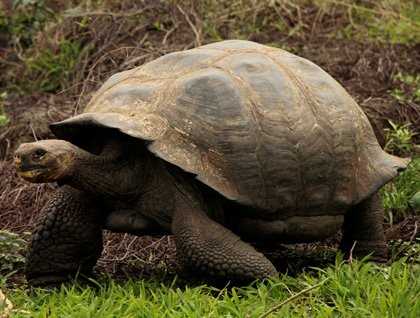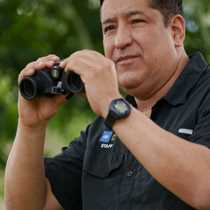It is Tuesday morning and we woke up with a wonderful view of Puerto Ayora, the capital of Santa Cruz Island. We had great expectations to observe today the most emblematic animal species of the Galápagos Islands: the majestic giant tortoises. We spent the morning visiting one of the longest-term and most successful conservation projects run by the Galápagos National Park Service and the Charles Darwin Research Station: the captive breeding and release program of the giant tortoises of the Galápagos.
In the breeding center we had the chance to appreciate first-hand the titanic efforts that have been done in order to save the giant tortoises from extinction. These huge antediluvian-looking creatures are truly fascinating to observe. From baby tortoises the size of a doughnut to huge individuals that can easily reach three hundred pounds, the tortoises had all the attention from our guests and lots of pictures were taken as souvenirs from these encounters.
One remarkable example found in these installations is the case of the Española giant tortoises. There were only twelve females and two males surviving in the wild of this saddleback subspecies. These individuals, roaming on their own over the small island, had zero breeding success due to their low population density. They were therefore taken to the breeding center to begin a long and successful repatriation program. Later on, a male from the same species was miraculously found in the San Diego Zoo and joined the small group very successfully, becoming the proud procreator of hundreds of baby tortoises that have since been repatriated to Española. I am talking about Diego! An individual who has gained respect through the years and who is considered the one who has replaced our beloved Lonesome George becoming a symbol for conservation as the late George was.
After this enlightening visit, we spent some time exploring Puerto Ayora town. We then continued to the highlands to visit a sugar cane mill where we learnt how some locals make a living cultivating coffee and sugar cane. Some guests opted to visit a local school while others preferred to ride mountain bikes.
After lunch in a paradisiacal location in the highlands, we explored the luxurious green Galápagos highlands. We observed the giant tortoises in their natural habitat. It was amazing to find many of these reptiles roaming free in the wild. We left the giant tortoise territory behind, covered by the mist, and headed back to town and then to the National Geographic Endeavour. Once on the ship we shared our impressions and adventures with our fellow travelers. We even had a party with lively music played by a local band that came onboard accompanied by beautiful dancing girls who wore typical Ecuadorian dresses. We can hardly wait what new memories our expedition around this magical archipelago will bring tomorrow to our lives.







